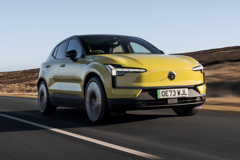Alfa Romeo Junior Elettrica Review 2025
Alfa Romeo Junior Elettrica At A Glance
Launching a model, especially of a kind an historic manufacturer’s not offered before, can be fraught with difficulties, not least with sceptics questioning the newcomer’s right to wear such a hallowed badge. How good is this newcomer to the growing ranks of small, electric SUVs? Find out with our comprehensive Alfa Romeo Junior Elettrica review.
To English-speakers’ ears, everything sounds better in Italian, hence this compact, electric SUV’s Elettrica suffix — by summer 2025 it will have been joined by a mild hybrid alternative, titled Ibrida. Weird, then, that Junior doesn’t sound at all Italian.
Therein lies the problem the Italian government had when the car was revealed using the Milano name — that sounds Italian, implying it is. In truth, this Alfa Romeo’s built in Poland alongside the closely related pair of the cutesy-but-again-retro Fiat 600e and the tiny-Tonka Jeep Avenger.
So, why Junior? It’s a name that Alfa Romeo has applied to less expensive versions of various of its ranges over the past 50 years, more often than not as a trim level, so the connection with its latest small car makes sense.
Just like Fiat and Jeep, Alfa Romeo is a brand name that’s now part of the enormous Stellantis group. Where multiple companies are brought together for cost-saving purposes, that inevitably means a sharing of expensive components, especially those that are seldom seen and — let’s face it — most car buyers don’t care about those anyway.
Hence the Alfa Romeo Junior Elettrica’s core underpinnings are also found under a whole suite of smaller EVs including the wannabe sophisticate DS 3 E-Tense, the metropolitan chic of the Peugeot E-2008 and the rather daring — for its maker — Vauxhall Mokka Electric.
Naturally, Stellantis doesn’t have the battery-powered compact SUV scene all to itself, which is why the Junior Elettrica looks so eye-catching. Whether its appealing is a matter of taste but there’s no denying it’s distinctive, especially on models with the abstract take on Alfa Romeo’s logo filling the shield-shaped grille’s void.
It’s the largest rendition of that famous badge to date, which may mean it’s also the first time many will spot that, yes, to the right of the cross — double-checks notes — it is a serpent eating a child.
In fact, around and inside the Junior Elettrica, you will find that logo dotted about everywhere — by the time we’d tallied-up more than a dozen, it started to feel a bit excessive, although that’s maybe a joke to rile the naysayers beamoaning that ‘it’s not a real Alfa Romeo…’. If it is, then fair play.
Still, with the bold Hyundai Kona Electric and the even more radical Kia EV3 to contend with, the Junior Elettrica has to be noticed.
Additionally, Alfa Romeo needs the Junior Elettrica to be perceived as an upmarket choice so it’s no surprise that other premium-priced brands have all recently launched models of similar sizes and prices.
Despite ditching much of the recent tweeness, the MINI Aceman will likely find favour with those wanting to champion a Brit despite it originating from elsewhere. Then there are the co-developed but very different to look at pair of the Smart #1 and Volvo EX30.
So, does the Alfa Romeo Junior Elettrica stand a fighting chance? Si, si! It’s engineering team has strived to give it a feel of its own, despite the shared hardware, with the result being an engaging, sporty little family SUV.
Fitted to the more powerful Veloce is a dialled-up motor that was co-developed with a specific team from Alfa Romeo, together with some bought-in tech that’s claimed to enable to it deal with its grunt very effectively.
Not only that, but it’s very well equipped, has fine performance, a decent range for its modest battery size and consequently feels like attractively good value. Ignore the naysayers doom-laden prophecies — the Junior could be Alfa Romeo’s best shot at glory in years.
Alfa Romeo Junior Elettrica: Range
| Alfa Romeo Junior Elettrica 156 | 247-255 miles |
| Alfa Romeo Junior Elettrica 280 | 201-207 miles |
Alfa Romeo Junior Elettrica handling and engines
Alfa Romeo Junior Elettrica 2025: Handling and ride quality
In lower-powered 156 guise, the Alfa Romeo Junior Elettrica strikes a sensible balance between sporty agility and acceptable levels of comfort for a small, family SUV.
It’s not uncommon for cars with shorter wheelbases — the distance between the front and rear wheels — to have bouncier rides than those with a greater gap, often amplified by carrying the additional weight of a battery pack.
Nevertheless, the Junior’s engineering team has done a fine job in ensuring that although firmer-riding than many other cars of this type, it’s not harsh or jarring over rougher surfaces and undulations. In fact, the damping settles it down quickly, appreciably more so than with larger EVs such as the Ford Explorer.
Junior 156s are fitted with 18-inch alloy wheels as standard, shod in relatively tall sidewalled tyres — 55-series if you’re so inclined — which further assist with the Alfa Romeo’s bump-absorption deftness.
Experience of the 280 Veloce has so far been limited to a circuit with a surface smoother than glass, but be aware that its suspension is both lower and stiffer than its less powerful siblings.
It’s party trick is an upgraded electronic differential for the front wheels — in non-techy language, this allows its 280PS to be metered-out accurately to either wheel based on factors such as grip and steering angle. The benefit of that is an ability to carry greater speed with increased levels of traction through corners.
Even on Junior 156s without the clever e-diff, the steering is quick-reacting, accurate and weighted appropriately so as not to feel like a chore on longer, less interesting drives.
Alfa Romeo’s three-setting DNA driving mode arrangement is present in the Junior Elettrica, although we’d welcome even more tangible step changes between the settings. Plus, without adaptive suspension, none of the settings vary the ride quality.
Alfa Romeo Junior Elettrica 2025: Engines
At least until summer 2025, the Alfa Romeo Junior will only be sold in battery-powered Elettrica format, with a choice of two outputs, each driving the front wheels only via a single-speed transmission.
Least costly of the two and set to be the more popular by far is the 156. Conveniently sharing its name with a much-loved Alfa Romeo range of saloons and estates from the late 1990s, it’s also the Junior Elettrica’s power output in PS.
Maximum torque — its pulling power for acceleration and overtaking — is 260Nm. While that’s not eye-catchingly high, as evidenced by a 0-62mph acceleration time of 9.0 seconds, it’s delivered in a smooth, linear way that avoid being boringly savage when zipping into a gap on roundabouts.
Top speed, which sensibly is of less interest to car buyers these days, is electronically capped at 93mph to help preserve the battery’s energy reserves.
Nevertheless, buyers of higher performance models do expect to be able to travel more quickly, hence why the Junior 280 Veloce’s limited maximum is higher at 124mph.
As yet, Alfa Romeo hasn’t quoted a 0-62mph time but with 280PS and 254Nm of torque on tap it will be significantly more brisk.
That additional confirmed power choice is for the Junior Ibrida, although this is a mild hybrid arrangement already seen in a wide array of other Stellantis cars. It will feature a 1.2-litre, three-cylinder petrol engine and a compact electric motor driving the front wheels through a six-speed dual-clutch automatic gearbox.
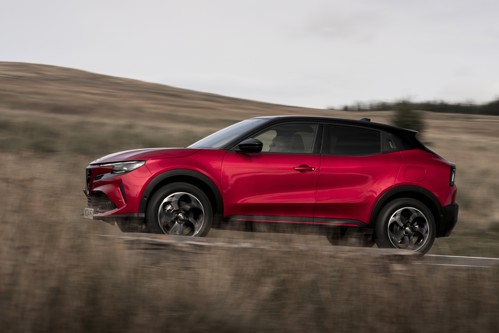
Alfa Romeo Junior Elettrica 2025: Safety
Euro NCAP has yet to get its hands on the Alfa Romeo Junior Elettrica to assess how well it protects occupants involved in an accident or prevents them from being involved with one in the first place. However, those responsible for selling it will hope it performs better than the most recent of its close cousins to be tested did when the Jeep Avenger totted-up just three stars.
Certainly, the key pieces of safety kit are available in the Junior, they’re just not necessarily standard-fit items across the range.
Take the entry-level Junior Elettrica 156 and range-topping 280 Veloce which have adaptive cruise control, automatic emergency braking with pedestrian and cyclist recognition, e-Call emergency services automatic dial-up and location sender, automatic LED head and tail lights, automatic wipers and rear parking sensors as standard.
Only the 156 Speciale has upgrades including blind-spot warning, traffic sign recognition, lane centring and traffic jam assist for the adaptive cruise control and a reversing camera.
These features are available on the other models as part of a Technology Pack for £2200, that additionally includes front and side parking sensors, an auto-dimming interior rear-view mirror and LED matrix headlights with automatic high-beam function.
For the Speciale, there’s a specific Technology Pack that takes into account features it already has, reducing the bill to £1350.
Alfa Romeo Junior Elettrica interior
Alfa Romeo Junior Elettrica 2025: Practicality
Car buyers often cite increased practicality as one of their primary motivations from switching from hatchbacks to SUVs, so there will be an expectation that the Alfa Romeo Junior Elettrica will deliver in this regard, despite its compact dimensions and slinky silhouette.
Largely it does, providing customers have tempered expectations generally and aren’t expecting a Tardis-esque trick when its doors are opened. After all, it’s very much the junior Alfa Romeo in the line-up at 4173mm from nose to tail, some 131mm shorter than the related Peugeot E-2008 yet 89mm longer than its Jeep Avenger cousin.
If you were aquainted with its most recent smaller models, the three-door Alfa Romeo Mito and the more practical, five-door Giulietta, you will find the Junior Elettrica fits between the two in terms of length and width but is taller than both.
Up front, there’s a sense of cosiness, amplified by the black interior finishes, the substantially bolstered seats and an impression of the car wrapping around you due to the angled dashboard and the height of the window sills. In reality, it’s plenty spacious, with a six-way adjustable driver’s seat that’s electrically operated on all barring the cheapest Junior.
A greater range of adjustment for the steering wheel wouldn’t go amiss, particularly in terms of how far back it extends. Taller drivers are likely to have to reach a compromise between being on the brink of stretching their arms or sitting more upright than they’d ideally choose to.
Accessing the Alfa Romeo Junior Elettrica’s rear seats involves using the high-mounted door handles, nestled into the window frame. Their position’s designed to hint at this being a sportier, three-door car, but Alfa — and a host of others — have played this card for so long it’s debatable whether anyone falls for it.
Nevertheless, it’s a momentary distraction from how limited space on the rear bench is — a common theme on many smaller cars where manufacturers are obliged to engineer in the ability to perform well in crash tests and EVs battery packs.
Although there are three seatbelts, more than two people in the back would soon feel claustrophobic. Adults of above average height will lament the prospect of a long journey behind lofty front seat occupants, but kids up to early teens will largely be fine.
There’s a pair of Isofix child seat mounting points in the outer two positions and the Junior’s slight elevation over more conventional hatchbacks means hoicking baby seats in and out isn’t as perilous for parents’ lower backs.
Alfa Romeo quotes a 400-litre boot capacity for the Junior Elettrica with the rear seats in place, which compares with the Avenger’s 355-litre volume and the E-2008’s 434-litre space. The seat back split/folds in a 60:40 configuration, although there are no remote control levers within the boot to drop them and they don’t lie completely flat, either.
Still, it’s a fairly continuous plane to slide cumbersome items along once you’ve negotiated the loading lip, with an overall capacity to roof height in two-seater mode of 1265 litres. For reference, the Avenger and E-2008 offer overall spaces of 1252 litres and 1467 litres, respectively.
If you want a dedicated place to store your Type 2 charging cable, your Alfa Romeo dealer will fit a lidded plastic tray atop the electric motor under the bonnet for £325. It’s handy but it feels excessively priced, when a pouch beneath the rear parcel shelf, as featured on the slightly larger Skoda Elroq, would have been a far less costly solution.
Elsewhere in the cabin, there’s an acceptable amount of storage spaces and cubbies but none are surprisingly large and the door pockets aren’t lined, so items slotted into them have a tendency to rattle around noisily.
Alfa Romeo Junior Elettrica 2025: Quality and finish
Inevitably, being the cheapest model in the range means that the Alfa Romeo Junior Elettrica’s interior furnishings aren’t going to feel as plush as those in the range-topping Stelvio, yet it manages to feel largely on par with the Tonale that’s sized between them.
Mostly, the Junior feels well-assembled and solid, although the centre console trim on one version we tried was loose and refused to clip back into place securely.
One aspect that will immediately strike you when you settle in behind the Alfa Romeo Junior’s wheel is how many different surface textures surround you, even before you touch them. Different grains of leather-look mouldings sit alongside glossy black plastic surfaces, punctuated by metal-look details and cushioned fillets trimmed in textiles such as faux suede and something else along the lines of neoprene.
While most elements your hands will regularly encounter are fine, others do feel on the cheap side, even for the least expensive Junior. Pray Britain remains perpetually overcast so that you don’t have to deal with those hard plastic sunvisors, complete with a rough edge from where they’ve been taken out of the mould.
There’s a substantial, pleasant chunkiness to the steering wheel without it being overly thick while the spoke-mounted controls for the adaptive cruise control and infotainment system initially look like haptic touchpads but are thankfully individual, physical buttons.
Ambient lighting also makes an appearance, including illuminating the partial Alfa Romeo symbols in the centres of the circular air vents on the outer edges of the dashboard. In fact, the more you look around inside the Junior, you realise that the brand name and logo is as omnipresent as it is outside.
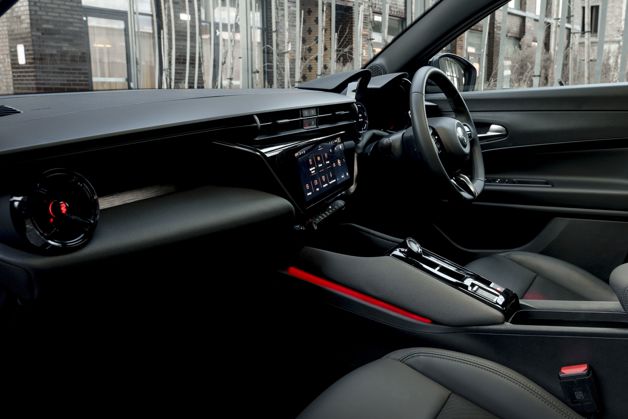
Alfa Romeo Junior Elettrica 2025: Infotainment
Two 10.25-inch screens keep you informed of the Alfa Romeo Junior Elettrica’s performance and efficiency metrics as well as the outside world.
Located in a double-curvature binnacle immediately ahead of the driver, the display is configurable, although its narrow, letterbox-like format restricts the size of the virtual instruments, so they’re smaller than is idea. Similarly, the fonts are scaled to match, requiring a moment or two’s additional study, during which your eyes are off the road.
Usefully, the infotainment touchscreen is significantly angled towards the driver — less usefully, it’s also mounted rather low down on the dash, so it doesn’t appear in your peripheral vision as readily as it might.
That’s a pity because it’s reasonably slick in operation, didn’t require repeated screen prodding and the graphics for the native navigation system — standard on all barring the entry-level model — have a clear, Google Maps-style vibe about them. These days, many prefer to use a car’s phone mirroring function instead, so usefully all Juniors have wireless Apple CarPlay and Android Auto capability.
As well as on-screen shortcut virtual buttons, there’s a simple-to-use bank of physical ones beneath the touchscreen, allowing for far easier control of audio volume and interior temperature settings.
Alfa Romeo Junior Elettrica value for money
Alfa Romeo Junior Elettrica 2025: Prices
In isolation, the notion of a starting price of just under £34,000 for such a relatively small car seems high, so it’s important to judge the Alfa Romeo Junior Elettrica in context.
Being an EV ramps the price up considerably, plus an SUV is always going to cost more than a comparably sized conventional hatchback. Plus, the Alfa Romeo name has a certain cachet that renders it a cut above mainstream.
Plus, there’s a very generous roster of standard equipment on the least expensive Junior Elettrica 156, in spite of its £33,895 price tag.
That’s less than the identical electric motor and battery pack set-up costs in the plush DS 3 E-Tense (£38,465), rugged Jeep Avenger (£34,999), sharp-suited Peugeot E-2008 (£35,200) and stylish Vauxhall Mokka Electric (£39,735), with only the friendly faced Fiat 600e of its in-house rivals undercutting the Junior at £32,995.
Elsewhere, the bold-but-unsporty Hyundai Kona Electric costs from £34,995, albeit with a smaller range, while the more radical — and larger batteried — Kia EV3 weighs in at £32,995.
Of the more upmarket alternatives Alfa Romeo has in its sights, the MINI Aceman starts at £31,800, with it’s perceived Britishness being a key draw for UK-based customers, even though its batteries are smaller.
Elsewhere, the Smart #1 can be had for £31,950 while the car it shares its under-body hardware with, the Volvo EX30, chimes in at £32,850. While the Smart and Volvo have smaller battery packs at the lower price points in their respective ranges, their power outputs at just 8PS shy of the range-topping Junior Veloce 280, for which Alfa Romeo asks £42,895.
Alfa Romeo Junior Elettrica 2025: Running Costs
As with all EVs, VED car tax will be chargeable on zero-emission cars from April 2025, although of the present range only the Junior 280 Veloce will fall foul of the additional duty payable on models costing in excess of £40,000 — that's an additional £425 to pay annually from the first anniversary of its registraion for five years.
For user-choosers considering an Alfa Romeo Junior Elettrica as a company car, its 0g/km CO2 output ensures it’s in the lowest Benefit-in-Kind (BIK) taxation bracket of 3% from April 2025.
Alfa Romeo Junior Elettrica: Range and charging
On the WLTP Combined cycle both the entry-level and Speciale 156 versions have claims of 4.0mi/kWh, equating to an overall range of 247-255 miles from its 54kWh battery. That’s marginally further than the other SUVs the Junior shares its electrical components with can travel between recharges.
Out in the real-world, that’s likely to be 200-220 miles in warmer months, depending on driving styles, typical routes and a whole host of other variables, likely dropping to 180-200 during winter.
Go for the punchier Junior Elettrica Veloce 280 and the WLTP Combined cycle range is quoted at 200-207 miles — us the performance liberally and you're unlikely to clock 150 miles before you're plugging it in again.
Even with the larger of its battery packs, the MINI Aceman has a maximum range of 252 miles, while the Smart #1 can go as far as 273 miles before needing to be plugged in but you’ll pay a smidge under £39,000 for the privilege, albeit with almost as much power as the Junior 280 Veloce.
Similarly, the Volvo EX30’s range is 209 miles with the smaller battery, rising to 295 with the lager one for £37,000.
With identical power to the Junior 156s, the entry-level Hyundai Kona Electric’s range is 234 miles despite its battery being smaller at 48kWh. Upgrading to the 65kWh version for a 319-mile range — and a power increase to 218PS — ramps the price up to £38,595.
In fact, only the Kia EV3 manages to trump the Alfa Romeo here by being less expensive, having a slightly larger battery and boasting 45PS more power — yet its claimed range is 270 miles.
When it comes to recharging, the Junior Elettrica can accept an AC flow of up to 11kW from a domestic wallbox and a relatively modest maximum of 100kW when hooked-up to a DC rapid charger.
At 11kW AC, a full 0-100% recharge will take in the order of 5 hours and 45 minutes, while at 100kW DC zapping-up from a 20% to 80% state of charge requires 27 minutes.
Satisfaction Index
 What is your car like to live with?
What is your car like to live with?
We need your help with our latest Satisfaction Index, so that we can help others make a smarter car buying decision. What's it like to live with your car? Love it? Loath it? We want to know. Let us know about your car - it will only take a few minutes and you could be helping thousands of others.
Help us with the Honest John Satisfaction Index nowAlfa Romeo Junior Elettrica models and specs
From launch, the Alfa Romeo Junior Elettrica range consists of three individual derivatives — 156, 156 Speciale and 280 Veloce.
Gateway to the range is the entry-level Alfa Romeo Junior Elettrica 156 yet despite being the least expensive, it doesn’t feel spartan. Its standard equipment includes 18-inch Aero diamond-cut alloy wheels, a sporty bodykit with a black finish, the Legenda Scudetto grille with the Alfa Romeo name diagonally across it, automatic LED head and tail lights, automatic wipers and rear parking sensors.
Inside it comes with a configurable 10.25-inch digital instrumentation screen, a 10.25-inch multimedia touchscreen with DAB radio, wireless Apple CarPlay and Android Auto connectivity, Alfa Connected Services, a four-speaker sound system, ambient lighting, electrically adjustable door mirrors, front and rear electric windows, automatic climate control, adaptive cruise control, automatic emergency braking, DNA driving mode selector, an electric parking brake with auto-hold, a volumetric anti-theft alarm, a central front armrest, 60:40 split-folding rear seats, fabric upholstery and a synthetic leather steering wheel.
EV-specific kit includes a home wallbox installation, an 11kW AC on-board charger, a Type 2 charging cable and a heat pump.
Building on that kit roster, the Alfa Romeo Junior Elettrica 156 Speciale adds an 18-inch Petali diamond-cut alloy wheels, a sports styling kit including the Diamond Black Scudetto grille featuring an abstract of the Alfa Romeo logo, keyless entry, dark-tinted rear privacy glass, a reversing camera, in-built navigation system, a six-speaker audio upgrade, lane centring and traffic jam assist, blind-spot warning, traffic sign recognition, upgraded front seats with heating and massage functions plus, for the driver’s side, electrical adjustment, a genuine leather steering wheel, sports pedals, door sill kick plates, a cargo flex kit and an electric tailgate.
Also using the cheapest model as its basis, in addition to its power increase, the Alfa Romeo Junior Elettrica 280 Veloce also features 20-inch Venti diamond-cut alloy wheels shod in high performance tyres, red front brake callipers, 25mm lower, stiffer suspension, the Diamond Black Scudetto grille, a contrasting black roof, dark-tinted rear privacy glass, upgraded front sports seats with heating and massage function, plus electrical adjustment on the driver’s side, a leather steering wheel, sports pedals, door sill kick plates and a cargo flex kit.
Various option pack bundles are available, with contents that vary depending upon the Junior derivative they are fitted to. In broad terms, the Premium Pack brings the entry-level 156 closer to the Speciale’s level of equipment, while the Sport Pack introduces Alcantara faux suede to various elements of the interior as well as sports front seats made by racing specialists Sabelt. Included within the Technology Pack are LED matrix headlights, a wireless smartphone charging pad and all-round parking sensors.
Individual options are limited to alloy wheel upgrades for the entry-level 156, the black roof finish and an electrically operated sunroof.
Model History
- October 2024: Alfa Romeo Junior Veloce confirmed, priced from £42,295
- February 2025: Alfa Romeo Junior Ibrida hybrid prices and specs confirmed, starts at £27,895
- March 2025: Range-topping Alfa Romeo Junior Elettrica Intensa models start at £38,905
October 2024
Alfa Romeo Junior Veloce confirmed, priced from £42,295
Order books have opened for the range-topping Alfa Romeo Junior Veloce. The 280PS version of the Junior is capable of up to 215 miles of range, and benefits from a Torsen limited-slip differential, 25mm lower suspension and upgraded brakes.
The Junior Veloce also benefits from 20-inch alloy wheels, a sports styling kit and a massage function for the driver's seat.
Alfa Romeo Junior pricing
Elettrica 156PS £33,895
Elettrica 156PS Speciale £35,695
Elettrica 280PS Veloce £42,295
February 2025
Alfa Romeo Junior Ibrida hybrid prices and specs confirmed, starts at £27,895
Alfa Romeo has confirmed the prices and specifications of the Junior Ibrida. The hybrid version of the Junior joins the Junior Elettrica EV in the line-up when orders open later this month and costs from £27,895.
The Junior Ibrida is powered by a 136PS hybrid system, which pairs a 1.2-litre petrol engine with a 21kW electric motor integrated into a six-speed dual-clutch gearbox.
Standard equipment includes 17-inch alloys, ambient lighting, rear parking sensors and keyless go.
The optional Technology Pack adds LED Matrix headlamps, a wireless charging pad, front, rear and side parking sensors and adaptive cruise control. The Premium Pack includes a cargo flex kit, dark tinted rear windows, leather steering wheel, black painted bodykit and heated and massaging seats.
Alfa Romeo Junior prices
Alfa Romeo Junior Ibrida 136hp £27,895
Alfa Romeo Junior Elettrica 156hp £33,895
Alfa Romeo Junior Elettrica Speciale 156hp £35,695
Alfa Romeo Junior Elettrica Veloce 280hp £42,295
March 2025
Range-topping Alfa Romeo Junior Elettrica Intensa models start at £38,905
Alfa Romeo has announced the new top of the range Junior Elettrica Intensa, with prices starting at £38,905.
The Intensa trim is a new range-topping model line that has been introduced to the Junior, Giulia, Stelvio and Tonale ranges.
Intensa models feature two-tone alloy wheels, Alcantara or leather upholstery with tan stitching, embossed Intensa logos on seats and a dashboard trimmed in Alcantara or leather.
A Harman Kardon audio system, adaptive cruise control and keyless entry are also included, as are Assistance and Technology Packs also included as standard.
The Junior Intensa is available in Tortona Black as standard and optionally in Brera Red. A Junior Ibrida Intensa model joins the line-up later in 2025.

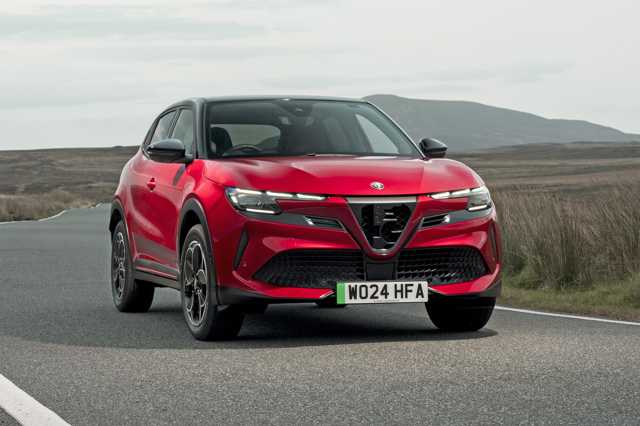

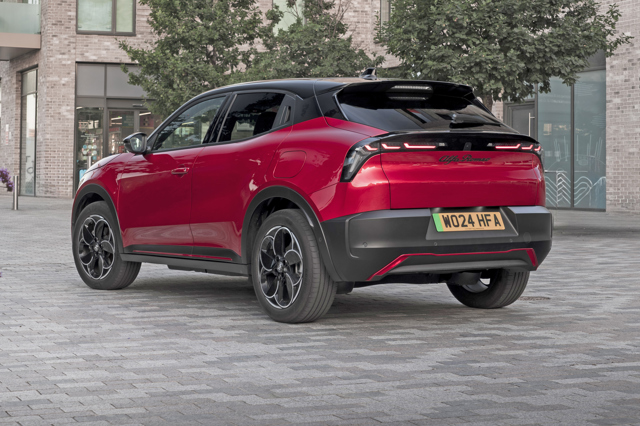
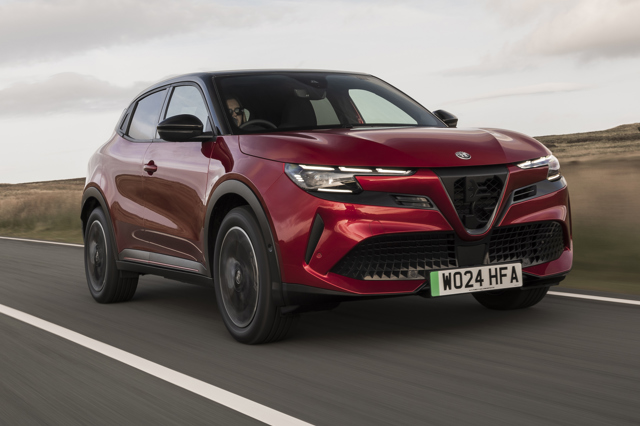
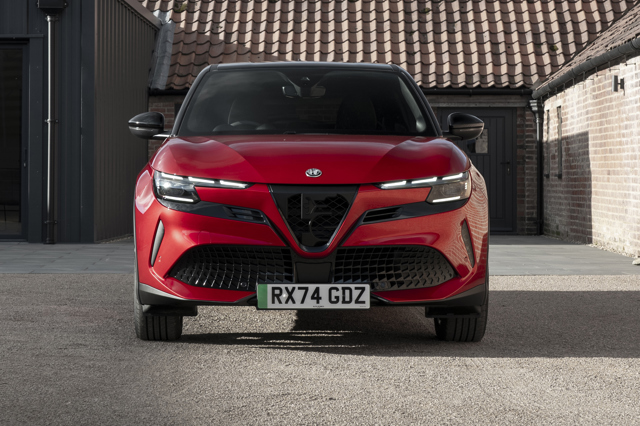
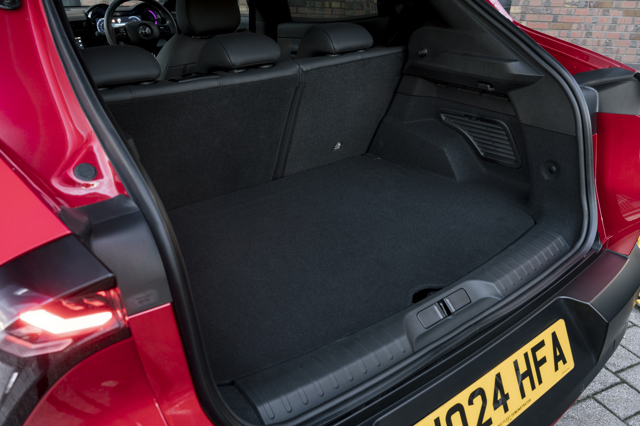
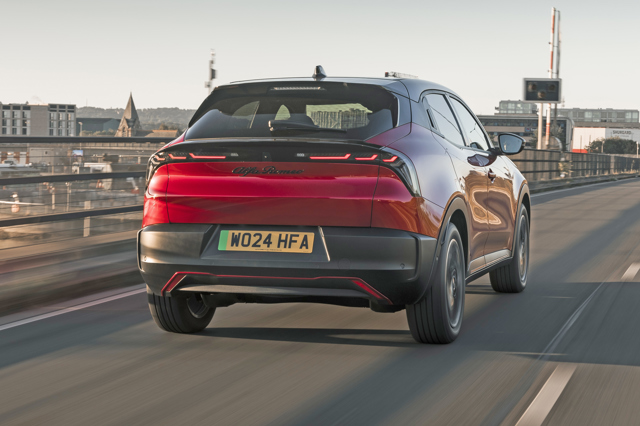
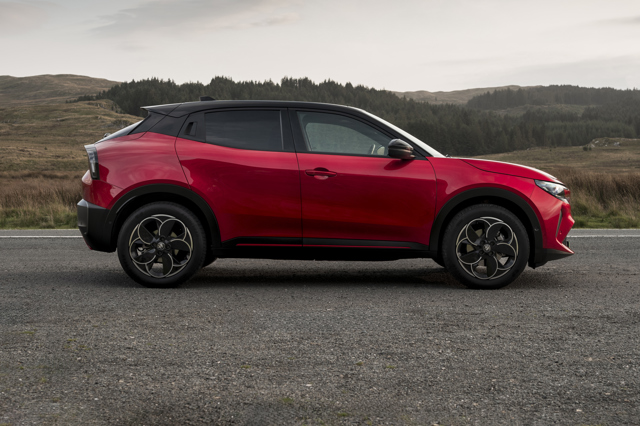


 Decent fun to drive without being uncomfortable. 156 models are fine value with strong levels of kit. Driving range is one of the longest.
Decent fun to drive without being uncomfortable. 156 models are fine value with strong levels of kit. Driving range is one of the longest.
 Cramped in the back for adults. Wide variety of interior finishes make it feel disjointed. Many overwrought styling details.
Cramped in the back for adults. Wide variety of interior finishes make it feel disjointed. Many overwrought styling details.



